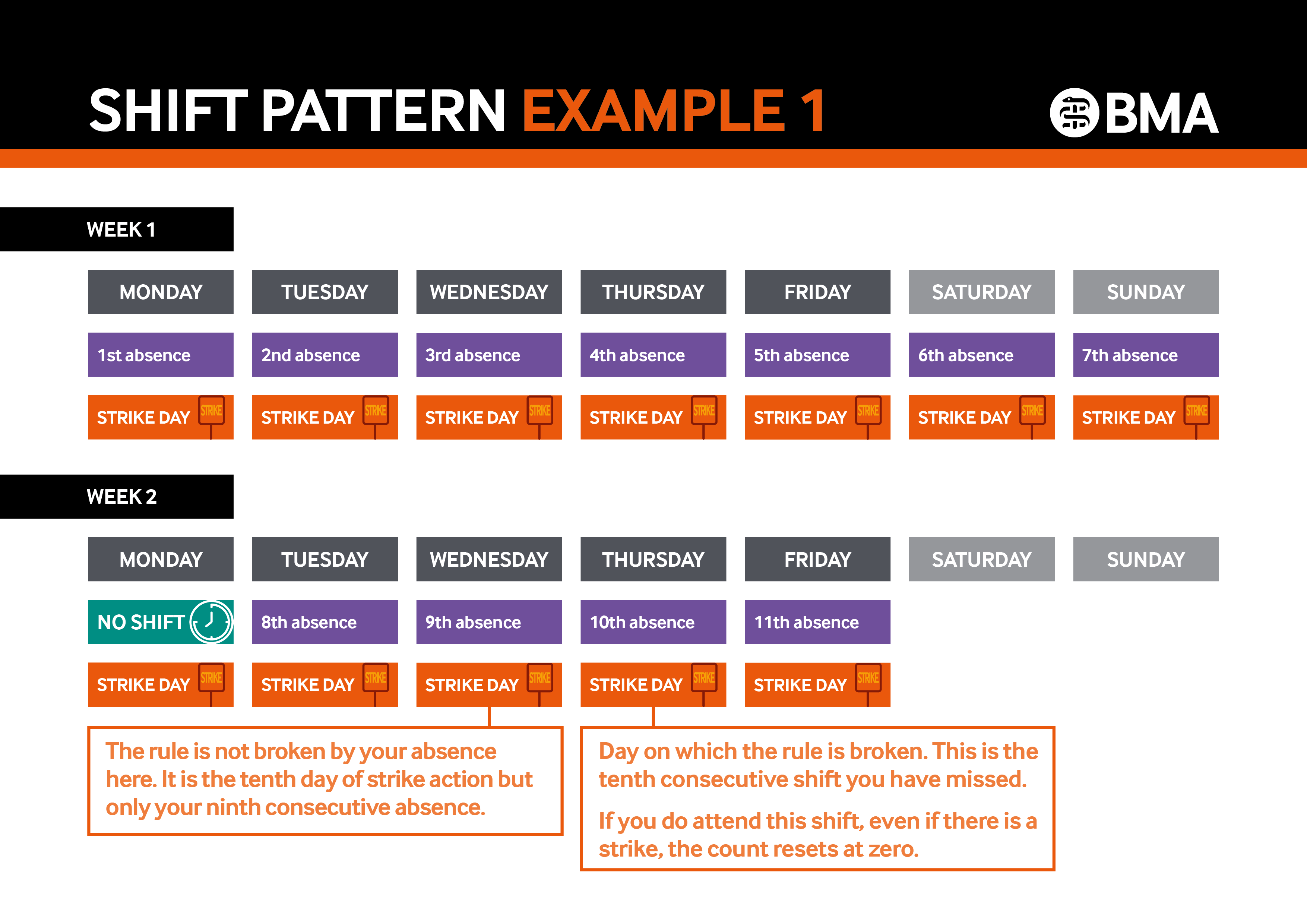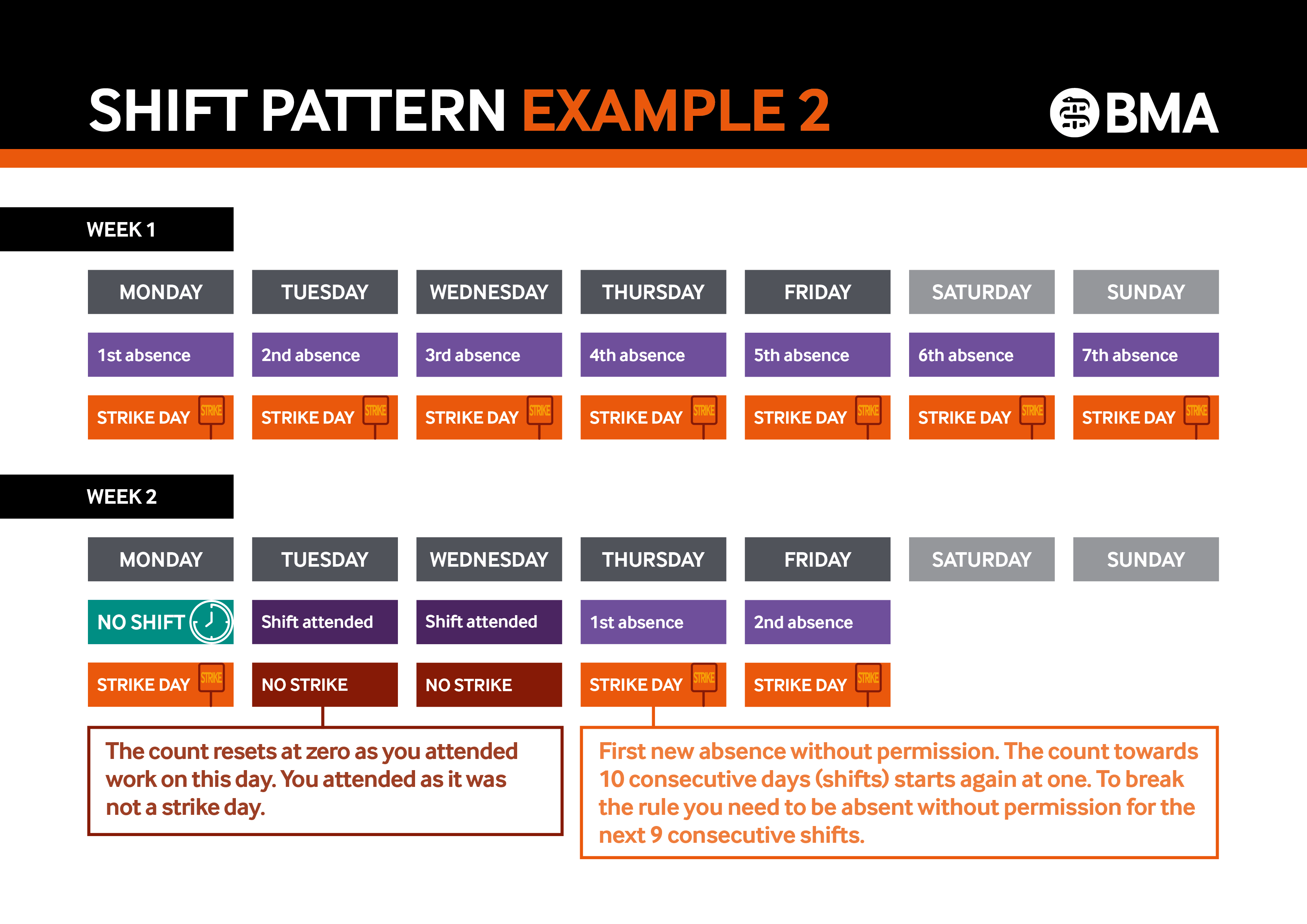Unpaid leave as a result of industrial action
Under current immigration guidance, unpaid leave taken to participate in legally organised industrial action is exempt from the rule that your sponsorship will be terminated if you are absent from work unpaid for 28 days or longer in a calendar year.
Unauthorised absences over 10 consecutive days
If you are absent from work for 10 consecutive working days or more without permission, your employer may be required to notify the Home Office of this absence. The Home Office will consider if further action is required.
Our legal interpretation is that this refers to missing 10 days in a row on which you were scheduled to work or had a shift and not 10 calendar days in a row. This means the count towards 10 consecutive missed working days in a row continues even if there are authorised non-working days that occur in between them. If a series of consecutive unauthorised absences is broken by a day that you did work as scheduled, the count resets at zero. It is the number of your consecutive unauthorised absences, rather than the consecutive number of days of resident doctor strike action in general, which would contribute to this count.
This is the basis upon which the BMA will fight for members in the unlikely event an employer takes action against them based on a different interpretation.
Below are example shifts over a two-week period of strike action which demonstrate how 10 consecutive days of unauthorised absence are calculated.
Unauthorised absences: example shift pattern 1
In the first example, you are absent due to legal industrial action for the entire period. If you were scheduled to work Monday to Sunday one week and then Tuesday to Friday the next, from the second Thursday, your employer would be required to notify the Home Office. This would be the tenth day of your absence.
 Table 1. Shift pattern in which unauthorised absences due to strike action break the 10 consecutive day rule
Table 1. Shift pattern in which unauthorised absences due to strike action break the 10 consecutive day rule
Unauthorised absences: shift pattern example 2
The example below demonstrates how the count resets if you work a shift that breaks a consecutive series of unauthorised absences. In this example, you are absent from work due to strike action for 7 consecutive days when you are scheduled to be working. There is no strike action on the day you are scheduled to have your next shift and so you attend work as usual. This would reset the count at zero from the perspective of the 10 consecutive day rule. Your next unauthorised absence would be considered the first in the count towards a new series of 10 consecutive days unauthorised absences.
 Table 2. Shift pattern example in which strike action does not break the 10 consecutive day rule
Table 2. Shift pattern example in which strike action does not break the 10 consecutive day rule
Please contact the BMA Immigration Advice Service for further advice if you have any concerns about any anticipated absence amounting to 10 consecutive working days without permission, or your employer seeks to interpret this period in another way.
Reduction in pay
If your salary is reduced for any period of time, your sponsor will be required to notify the Home Office. They must confirm the reason for the reduction of salary and the dates that the reduction is effective from and to.
Although your sponsor is required to report a reduction in salary to the Home Office, if the cause of this salary reduction is legally organised industrial action, the sponsor cannot end their sponsorship of your visa.
If you are impacted in any way by a reduction in salary that does not result from taking part in legally organised industrial action, please contact the BMA’s Immigration Advisory Service for further information and support.
ILR (Indefinite leave to remain)
There will be no impact on your eligibility for further leave to remain or ILR (indefinite leave to remain) in regard to salary reduction or excessive unpaid leave where the reason for either is legally organised industrial action.
If you are absent from work unauthorised for more than 10 consecutive days, you are at risk of impacting your current visa and any future applications.
If you have particular circumstances that you wish to discuss or that do not fall within the guidance set out above, please contact the BMA’s Immigration Advisory Service for further information and support.
Tier 5 visas
There may be direct impacts from taking industrial action whilst on a Tier 5 visa. Should salary be reduced below the national minimum wage level as a result of industrial action, then your sponsor will need to conduct a report notifying the Home Office that this is the case.
Medical academies (the sponsor of tier 5 visas) have confirmed that participating in legally organised industrial action is a permitted absence for MTI doctors (doctors with a tier 5 visa). The sponsor would only need to report to UKVI if industrial action brought a doctor’s annual pay below the national minimum wage.
Reporting procedures for visa holders
Following extensive discussions with HEE, we can confirm that doctors sponsored by HEE with visa restrictions, regardless of which visa they have, need to report to HEE via an online form that they have undertaken industrial action within 10 days after the day of action (section C1.12 of this guidance). Please refer to further HEE guidance for reference.
We can also confirm following assurances from HEE, that once this information is received from the trainee, they will report it directly to the UKVI (UK Visas and Immigration) and will not pass on any information to other bodies such as the employers.
The reporting process at trusts for absences without permission/unpaid absences involves a Level 1 User (usually, a named HR representative) sending an online report directly to the Home Office confirming any reportable change/activity.
The Home Office imposes an obligation on sponsors to report certain types of employment activity relating to sponsored workers within a 10-working day period of the activity taking place. This is the only mandated timeframe in relation to reporting on sponsored worker absences. We would therefore encourage IMGs with trust sponsors to report their absence as strike action to their overseas sponsorship team within 10 days of returning to work.
Should an employer seek to propose a reporting methodology that differs from that of the Home Office guidance as outlined above, please contact us for support.
Junior doctors who have settlement in the UK, whether that is Settled Status (EU Settlement Scheme) or ILR (remainder of the Immigration Rules), fall outside of the scope of these reporting requirements.
The income threshold required to be met for most spouse visa applications submitted in the UK will is ordinarily a combined income of least £18,600 (some exceptions can apply).
It is highly unlikely that a junior doctor would fail to meet the financial threshold for this visa category by taking strike action. However, if you feel your personal circumstances would put you in jeopardy of being below the financial threshold for your visa, please contact the BMA immigration advisory service.
If you are on a ‘personal’ visa category such as pre-settled status, you are not sponsored by your employer and so are not under an immigration obligation to report to your employer any plan to take industrial action.
Your employer is under no obligation to report the individual employees’ activity either, as this is not a sponsored role.
The right to take industrial action is available to all junior doctors, including those with refugee status.
However, there are a number of different types of status for those who are refugees and, as with all visa types, conditions attached to a visa can differ from individual to individual.
In order for the BMA to best support members, should an individual with a refugee status have a specific question regarding the impact of taking industrial action, please contact the BMA immigration advisory service and we will be able to provide individual support and advice.
Industrial action webinar for IMGs
If you can't find the information you need in this guide, send us your questions here and we will add the answers to these pages.
Or contact us via our employment advice form if you have a question about your personal circumstances.
As of 18 September, all references to junior doctors in BMA communications have been changed to ‘resident doctors’.
Making up nearly 25% of all doctors in the UK, this cohort will now have a title that better reflects their huge range of skills and responsibilities.
Find out more about why junior doctors are now known as 'resident doctors'.
